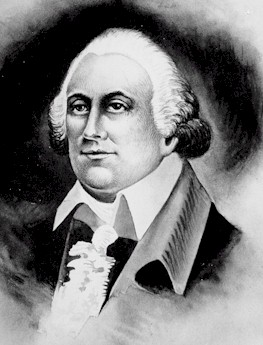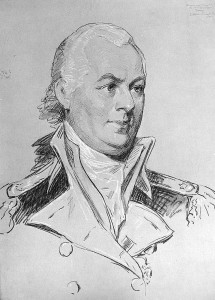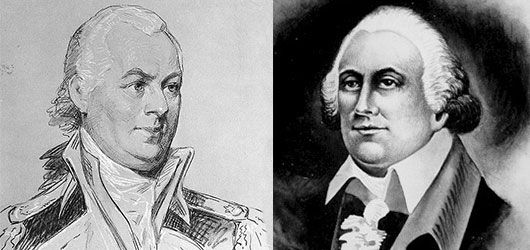By Russell W. Wylie
The traditional values of The Society of The Friendly Sons of St. Patrick were most aptly described by Mayor William J. Green III (the 120th Mayor of Philadelphia and member of the Society) in the preface of Society historian Dennis J. Clark’s book chronicling the history of the Society from 1951-1981. Mayor Green wrote, “The Friendly Sons of St. Patrick has enjoyed this nation’s tradition of freedom of association while bringing together Irish-Americans of different religious and political persuasions to unite in service to human needs and to support the aspirations of the Irish people.”
It was in this spirit that the founding members of the Society gathered on March 17, 1771 to elect Stephen Moylan as the first president of this Irish America fraternal organization. Although the membership was predominantly Protestant, the founding members demonstrated equability by electing a Catholic as the Society’s first president.

Stephan Moylan
Many of the founding members were businessmen in Philadelphia involved in the shipping business and leaders of the American Revolution. Stephen Moylan came to Philadelphia in 1768 where he organized his own shipping firm. It is not widely known that it was Stephen Moylan who is attributed to have first used the term “United States of America” as General Washington’s aide-de-camp from the Continental Army’s headquarters in Cambridge, Massachusetts in a letter to Col. Joseph Reed on January 2, 1776.
Col. Moylan was appointed to command the 4th Continental Light Dragoons, also known as Moylan’s Horse, on January 3, 1777 at Philadelphia. He succeeded General Pulaski as Commander of the Cavalry in March 1778. Stephen Moylan was rewarded for his service in the Continental Army by being breveted to brigadier general on November 3, 1783.
Two other founding members of the Society who came from Catholic backgrounds were George Meade and Thomas Fitzsimons. George Meade’s father, Robert, was born in Ireland and became a shipping and commission agent in Philadelphia who was influential in helping to establish Old St. Joseph’s Church in 1733; the first Catholic Church in Philadelphia founded under William Penn’s doctrine of religious freedom. George Meade went into business with his brother-in-law, Thomas Fitzsimons, who married Catherine Meade in 1761. Their firm, George Meade and Company, became one of the leading commercial houses in Philadelphia specializing in the West India trade.
George Meade was the grandfather of Civil War General George Gordon Meade, Commander of the Army of the Potomac at the Battle of Gettysburg. Thomas Fitzsimons was an active political leader serving as a delegate to the Continental Congress in 1782 and 1783, and a member of Pennsylvania’s House of Representatives in 1786 and 1787. He was a delegate to the U.S. Constitutional Convention in 1787 when he had the distinction of being one of only two Catholic signers of the United States Constitution. Following his withdrawal from politics, Fitzsimons served as a director of the Bank of North America, president of Philadelphia’s Chamber of Commerce, and a trustee of the University of Pennsylvania.
John Dickinson and Robert Morris were two of six honorary founding members of the Society. John Dickinson was a prominent solicitor and politician from Philadelphia with family ties through ancestry and marriage to wealthy Quaker families with large land holdings in Delaware, Maryland, and Pennsylvania.
Dickinson was a Pennsylvania delegate to the First Continental Congress in 1774 and the Second Continental Congress in 1775 and 1776. He prepared the first draft of the Articles of Confederation and was one of its signers. Dickinson served as a brigadier general of the Pennsylvania militia and then was elected the president of the State of Delaware in 1781. He was drawn back into Pennsylvania politics and returned to Philadelphia to serve as president of Pennsylvania from 1782-1785. Dickinson was a delegate to the U.S. Constitutional Convention in 1787 where he was a signer of the United States Constitution.
Robert Morris formed a partnership in 1757 with Thomas Willing called Willing, Morris & Company which grew to become one of the most prosperous merchant firms in Pennsylvania with interests in shipping, real estate, and other lines of business. The first ship purchased by Congress for the Continental Navy at the outset of the Revolutionary War was The Black Prince, the finest merchant ship in the service of Willing, Morris & Co. This sleek 200-ton ship had just returned from a record breaking voyage from England under the command of Captain John Barry traveling 237 miles by dead reckoning in a 24 hour period – the fastest day of sailing recorded in the 18th century. Morris became chairman of the secret committee authorized by Congress to engage in foreign trade ventures at a time when such trade was not allowed by the continental embargo.
This high-risk mission of the secret committee generated a clandestine trade exporting produce and importing weapons, gunpowder, lead for bullets, and supplies desperately needed by the army. It was a cargo of these important military supplies which arrived in the port of Philadelphia on board the Andrew Doria a few days before Christmas and was transported to General Washington’s army by wagons secured by Morris that allowed the daring raid across the Delaware against the Hessian soldiers garrisoned at Trenton.
Morris also raised funds backed by his personal guarantee to pay the troops and keep them fighting with the Continental Army in the successful battle of Princeton. Known as the “Financier of the Revolution”, Robert Morris was appointed by the unanimous vote of Congress to be Superintendent of Finance of the United States, and he served in that position from 1781 to 1784.

Commodore John Barry
Morris proposed the establishment of a national bank, which became the Bank of North America founded in 1782. The bank’s initial role was to finance the war against Britain and a large portion of the funding of the bank came from a loan Morris had obtained from France. He was a signer of the Articles of Confederation, the Declaration of Independence, and the United States Constitution.
Commodore John Barry became a member of the Society in 1779. He emigrated from County Wexford, Ireland to Philadelphia, working his way up from a cabin boy to become a leading captain of merchant ships for Robert Morris’ shipping company. At the start of the American Revolution, Captain John Barry offered his services to George Washington and Congress in the cause of American Liberty. During the course of the American Revolution, Barry was the commander of three ships, was seriously wounded, and captured 20 British ships. On February 22, 1797, President Washington called Barry to the President’s mansion at 190 High (Market) Street, to receive Commission Number One in the Navy. It was backdated to June 7, 1794, the date of his original appointment. Barry outfitted and supervised the construction of the first frigates built under the Naval Act of March 27, 1794, including his own 44-gun frigate, the USS United States, which was to serve as his flagship. Commodore John Barry remained the commanding officer of the U.S. Navy under President John Adams and President Thomas Jefferson.



